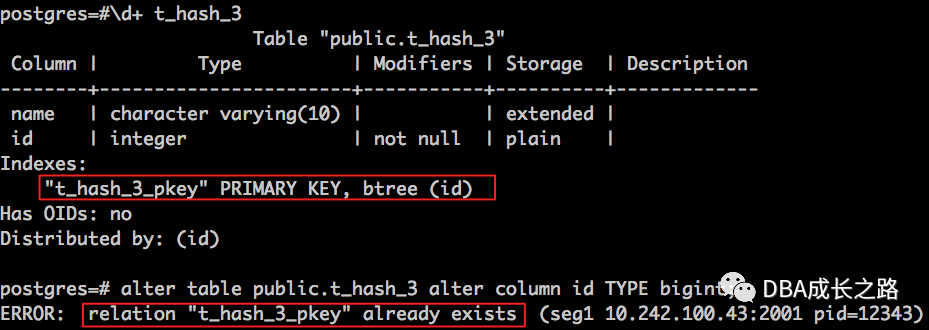主键和键限制
主键约束是约束和非空约束的组合。GP数据库为每个unique或primary key约束自动创建unique索引来强制执行性。因此,无需为主键列显式创建索引。
Appendonly追加表不支持主键和键约束
在追加优化表上不允许使用unique和primary key约束,因为由约束创建的unique索引在追加优化表上不允许

随机分布的表不支持主键和键约束
GP表如果需要建键,表必须是哈希分布的(不是随机分布)。即随机分布不支持主键(约束+非空约束)和键,因为随机分布保证不了整体数据的性。

有约束未指定分布键的表会将键作为分布键
如果表中含有键,但是没有指定分布键,则GP会默认将键作为表的分布键

同一个表不支持同时存在两个约束的字段
GP数据库不支持同时存在两个的字段(复合主键除外)。


分布键必须是主键列约束的左子集并且列的顺序是正确的
例如,如果主键是(a,b,c),该分布键只能是以下集合之一:(a),(a,b),或(a,b,c)

不能直接修改主键类型
直接修改主键类型报错如下:ERROR: relation "XXXXX" already exists

正确的修改方式
先drop主键类型,修改类型后,再进行主键的重新创建
postgres=# ALTER TABLE public.t_hash_3 drop CONSTRAINT t_hash_3_pkey;
ALTER TABLE
postgres=# alter table public.t_hash_3 alter column id TYPE bigint;
ALTER TABLE
postgres=# ALTER TABLE public.t_hash_3 ADD CONSTRAINT t_hash_3_pkey primary key(id);
NOTICE: ALTER TABLE / ADD PRIMARY KEY will create implicit index "t_hash_3_pkey" for table "t_hash_3"
ALTER TABLE
如果报约束名不存在时,可以去数据字典(pg_class和pg_constraint)中查找实际的约束名
postgres=# select oid from pg_class where relname='t_hash_3';
oid
-------
73870
(1 row)
postgres=# select conname from pg_constraint where conrelid=73870;
conname
---------------
t_hash_3_pkey
(1 row)
serial类型
如果业务需要实现自增,我们会推荐serial类型。但是某业务反馈该类型并不能达到自增的效果,因此好好研究了下该类型的用法。
GP沿用postgresql序列号(SERIAL)类型,postgresql中包括smallserial(smallint,short),serial(int)和bigserial(bigint,long long int)三种,本文测试使用的gp5.x版本只支持serial。
序列号类型其实不是真正的类型,当声明一个字段为序列号类型时其实是通过建立一个全局序列 表名_字段名_seq 实现的,INSERT时如果没有给该字段赋值会默认获取对应序列的下一个值。
添加自增字段的两种方式
通过serial自动创建序列
postgres=# create table tuniq(id serial, name text);
NOTICE: CREATE TABLE will create implicit sequence "tuniq_id_seq" for serial column "tuniq.id"
NOTICE: Using default RANDOM distribution since no distribution was specified.
HINT: Consider including the 'DISTRIBUTED BY' clause to determine the distribution of rows.
CREATE TABLE
postgres=# \d tuniq
Table "public.tuniq"
Column | Type | Modifiers
--------+---------+----------------------------------------------------
id | integer | not null default nextval('tuniq_id_seq'::regclass)
name | text |
Distributed randomly
通过sequence自定义序列
除了上述通过使用serial类型来自动创建序列,我们也可以先创建一个序列,然后将表的某字段默认值设为该序列的下一个序列值。
通过\h查看创建序列的语法
postgres=# \h create sequence
Command: CREATE SEQUENCE
Description: define a new sequence generator
Syntax:
CREATE [ TEMPORARY | TEMP ] SEQUENCE name [ INCREMENT [ BY ] increment ]
[ MINVALUE minvalue | NO MINVALUE ] [ MAXVALUE maxvalue | NO MAXVALUE ]
[ START [ WITH ] start ] [ CACHE cache ] [ [ NO ] CYCLE ]
[ OWNED BY { table.column | NONE } ]
含义如下
postgres=# create sequence sql_tbl_serial2_a;
CREATE SEQUENCE
postgres=# create table tbl_serial2(a int not null default nextval('sql_tbl_serial2_a'),b varchar(2));
NOTICE: Using default RANDOM distribution since no distribution was specified.
HINT: Consider including the 'DISTRIBUTED BY' clause to determine the distribution of rows.
CREATE TABLE
postgres=# \d+ tbl_serial2
Table "public.tbl_serial2"
Column | Type | Modifiers | Storage | Description
--------+----------------------+---------------------------------------------------------+----------+-------------
a | integer | not null default nextval('sql_tbl_serial2_a'::regclass) | plain |
b | character varying(2) | | extended |
Has OIDs: no
Distributed randomly
--或者在已经好的表添加默认值约束
postgres=> ALTER TABLE tbl_serial2 ALTER id set default nextval('sql_tbl_serial2_a'::regclass);
ALTER TABLE
查询自增字段定义信息
tuniq_id_seq为通过serial自动创建的序列。可通过\d 序列名,可直接查看到序列的定义
postgres=# \d tuniq_id_seq
Sequence "public.tuniq_id_seq"
Column | Type | Value
---------------+---------+---------------------
sequence_name | name | tuniq_id_seq
last_value | bigint | 1
increment_by | bigint | 1
max_value | bigint | 9223372036854775807
min_value | bigint | 1
cache_value | bigint | 1
log_cnt | bigint |
is_cycled | boolean | f
is_called | boolean | f
serial范围
通过\d查看到序列的大值为9223372036854775807,然而我们测试,发现由于id字段本身是int类型,所以当超出int范围会报错
postgres=# insert into tuniq values(9223372036854775807, 'zero');
ERROR: integer out of range
postgres=# insert into tuniq values(9223372036854775806, 'zero');
ERROR: integer out of range
查找资料,验证serial类型的范围如下:
如何增大自增字段的大值
由上可知,通过serial类型,大值只能到2147483647。如果该范围已经不够用。可通过先建序列,再与声明为bigint的字段建立约束即可。如下
postgres=# create sequence sql_tbl_serial2_a increment by 1 minvalue 1 maxvalue 9223372036854775807 start with 1;
CREATE SEQUENCE
postgres=# create table tbl_serial2(a bigint not null default nextval('sql_tbl_serial2_a'),b varchar(2));
NOTICE: Using default RANDOM distribution since no distribution was specified.
HINT: Consider including the 'DISTRIBUTED BY' clause to determine the distribution of rows.
CREATE TABLE
postgres=# \d+ tbl_serial2
Table "public.tbl_serial2"
Column | Type | Modifiers | Storage | Description
--------+----------------------+---------------------------------------------------------+----------+-------------
a | bigint | not null default nextval('sql_tbl_serial2_a'::regclass) | plain |
b | character varying(2) | | extended |
Has OIDs: no
Distributed randomly
postgres=# insert into tbl_serial2 values(9223372036854775807, 'ze');
INSERT 1
自增字段往往伴随约束
如果不建立约束,会出现如下问题。
postgres=> create table tuniq(id serial, name text);
CREATE TABLE
postgres=> insert into tuniq (name) values('zero');
INSERT 1
postgres=> insert into tuniq (name) values('second');
INSERT 1
postgres=>
postgres=>
postgres=> select * from tuniq;
id | name
----+--------
1 | zero
2 | second
(2 rows)
--继续在自增字段插入一样的值,不会报错。
postgres=> insert into tuniq (id, name) values(1, 'second');
--出现自增字段重复,与业务预期不符
postgres=> select * from tuniq;
id | name
----+--------
1 | zero
2 | second
1 | second
(3 rows)
该问题可通过在自增字段建立键约束解决。
自增字段为什么没有生效
如果有时候自增字段由oltp系统同步过来。有时候又需要在GP内部执行不包括自增字段的数据插入情况。
这个时候,因为sequence的当前新值尚未更新,所以可能会出现与已导入数据冲突的情况,如:
postgres=> create table tuniq(id serial unique, name text);
CREATE TABLE
postgres=> insert into tuniq values(, 'zero');
INSERT 1
postgres=> insert into tuniq values(1, 'first');
INSERT 1
postgres=> select * from tuniq;
id | name
----+-------
| zero
1 | first
(2 rows)
postgres=> insert into tuniq (name) values('second');
ERROR: duplicate key value violates unique constraint "tuniq_id_key"
DETAIL: Key (id)=(1) already exists.
此时我们需要先将序列值进行更新,才可正常运行。如下:
postgres=> select setval('tuniq_id_seq', max(id)) from tuniq;
setval
--------
1
(1 row)
postgres=> insert into tuniq (name) values('second');
INSERT 1
postgres=> select * from tuniq;
id | name
----+--------
| zero
1 | first
2 | second
(3 rows)
序列的函数使用
总结三点
serial是通过sequence设置字段的默认值
可以考虑加上约束,防止主动插入该字段的值,破坏该字段值的自增序和性(如果业务关心的话)
如果自增字段需要从外部同步,又需要在内部产生的场景,需要及时更新序列的新值。
参考
http://www.dbdream.com.cn/ https://gp-docs-cn.github.io/docs/refguide/sqlcommands/CREATE_TABLE.html https://yq.aliyun.com/articles/64314 https://blog.csdn.net/u012352957/article/details/84577468
